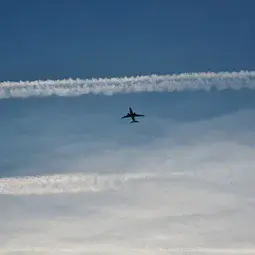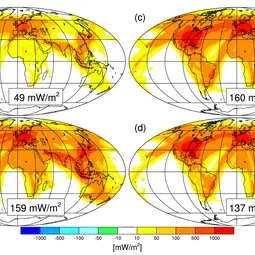Climate impact of clouds made from airplane contrails may triple by 2050
27 June 2019
In the right conditions, airplane contrails can linger in the sky as contrail cirrus – ice clouds that can trap heat inside the Earth’s atmosphere. Their climate impact has been largely neglected in global schemes to offset aviation emissions, even though contrail cirrus have contributed more to warming the atmosphere than all CO2 emitted by aircraft since the start of aviation. A new study published in the European Geosciences Union (EGU) journal Atmospheric Chemistry and Physics has found that, due to air traffic activity, the climate impact of contrail cirrus will be even more significant in the future, tripling by 2050.
Contrail cirrus change global cloudiness, which creates an imbalance in the Earth’s radiation budget – called ‘radiative forcing’ – that results in warming of the planet. The larger this radiative forcing, the more significant the climate impact. In 2005, air traffic made up about 5% of all anthropogenic radiative forcing, with contrail cirrus being the largest contributor to aviation’s climate impact.
“It is important to recognise the significant impact of non-CO2 emissions, such as contrail cirrus, on climate and to take those effects into consideration when setting up emission trading systems or schemes like the Corsia agreement,” says Lisa Bock, a researcher at DLR, the German Aerospace Center, and lead-author of the new study. Corsia, the UN’s scheme to offset air traffic carbon emissions from 2020, ignores the non-CO2 climate impacts of aviation.
But the new Atmospheric Chemistry and Physics study shows these non-CO2 climate impacts cannot be neglected. Bock and her colleague Ulrike Burkhardt estimate that contrail cirrus radiative forcing will be 3 times larger in 2050 than in 2006. This increase is predicted to be faster than the rise in CO2 radiative forcing since expected fuel efficiency measures will reduce CO2 emissions.
The increase in contrail cirrus radiative forcing is due to air traffic growth, expected to be 4 times larger in 2050 compared to 2006 levels, and a slight shift of flight routes to higher altitudes, which favours the formation of contrails in the tropics. The impact on climate due to contrail cirrus will be stronger over Northern America and Europe, the busiest air traffic areas on the globe, but will also significantly increase in Asia.
“Contrail cirrus’ main impact is that of warming the higher atmosphere at air traffic levels and changing natural cloudiness. How large their impact is on surface temperature and possibly on precipitation due to the cloud modifications is unclear,” says Burkhardt. Bock adds: “There are still some uncertainties regarding the overall climate impact of contrail cirrus and in particular their impact on surface temperatures because contrail cirrus themselves and their effects on the surface are ongoing topics of research. But it’s clear they warm the atmosphere.”
Cleaner aircraft emissions would solve part of the problem highlighted in the study. Reducing the number of soot particles emitted by aircraft engines decreases the number of ice crystals in contrails, which in turn reduces the climate impact of contrail cirrus. However, “larger reductions than the projected 50% decrease in soot number emissions are needed,” says Burkhardt. She adds that even 90% reductions would likely not be enough to limit the climate impact of contrail cirrus to 2006 levels.
Another often discussed mitigation method is rerouting flights to avoid regions particularly sensitive to the effects of contrail formation. But Bock and Burkhardt caution about applying measures to reduce the climate impact of short-lived contrail cirrus that could result in increases in long-lived CO2 emissions, in particular given the uncertainties in estimating the climate impact of contrail cirrus. They say that measures to reduce soot emissions would be preferable to minimise the overall radiative forcing of future air traffic since they do not involve an increase of CO2 emissions.
“This would enable international aviation to effectively support measures to achieve the Paris climate goals,” Burkhardt concludes.
###
Please mention the name of the publication (Atmospheric Chemistry and Physics) if reporting on this story and, if reporting online, include a link to the paper (https://www.atmos-chem-phys.net/19/8163/2019/) or to the journal website (https://www.atmospheric-chemistry-and-physics.net/).
More information
This research is presented in the paper ‘Contrail cirrus radiative forcing for future air traffic’ published in the EGU open access journal Atmospheric Chemistry and Physics on 27 June 2019.
The study was conducted by Lisa Bock and Ulrike Burkhardt (Institute of Atmospheric Physics, DLR).
Citation: Bock, L. and Burkhardt, U.: Contrail cirrus radiative forcing for future air traffic, Atmos. Chem. Phys., 19, 8163-8174, https://doi.org/10.5194/acp-19-8163-2019, 2019
The European Geosciences Union (EGU) is the leading organisation for Earth, planetary and space science research in Europe. With our partner organisations worldwide, we foster fundamental geoscience research, alongside applied research that addresses key societal and environmental challenges. Our vision is to realise a sustainable and just future for humanity and for the planet. We publish a number of diverse scientific journals, which use an innovative open access format, and organise topical meetings, and education and outreach activities. The annual EGU General Assembly is the largest and most prominent European geosciences event, attracting over 16,000 scientists from all over the world in 2019. The meeting’s sessions cover a wide range of topics, including volcanology, planetary exploration, the Earth’s internal structure and atmosphere, climate, as well as energy and resources. The EGU General Assembly 2020 is taking in Vienna, Austria, from 3 to 8 May 2019. For information and press registration, please check https://www.egu.eu/gamedia closer to the time of the event, or follow the EGU on Twitter and Facebook.
If you wish to receive our press releases via email, please use the Press Release Subscription Form at https://www.egu.eu/news/subscribe/. Subscribed journalists and other members of the media receive EGU press releases under embargo (if applicable) 24 hours in advance of public dissemination.
Atmospheric Chemistry and Physics (ACP) is an international scientific journal dedicated to the publication and public discussion of high-quality studies investigating the Earth’s atmosphere and the underlying chemical and physical processes. It covers the altitude range from the land and ocean surface up to the turbopause, including the troposphere, stratosphere, and mesosphere.
Contact
Researchers
Ulrike Burkhardt
Researcher, Institute of Atmospheric Physics, DLR
Oberpfaffenhofen-Wessling, Germany
Phone +49 8153 28-2561
Email Ulrike.burkhardt@dlr.de
Languages German, English
Lisa Bock
Researcher, Institute of Atmospheric Physics, DLR
Oberpfaffenhofen-Wessling, Germany
Phone +49 8153 28-1516
Email lisa.bock@dlr.de
Languages German, English
Press officer
Bárbara Ferreira
EGU Media and Communications Manager
Munich, Germany
Email media@egu.eu
EGU on Twitter: @EuroGeosciences


